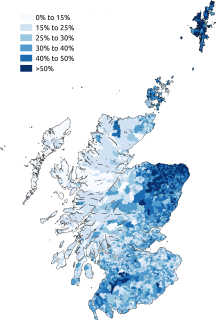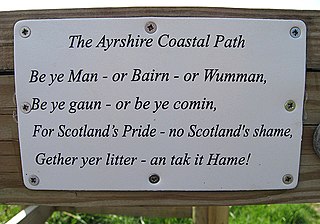Related Research Articles

The letter yogh (ȝogh) was used in Middle English and Older Scots, representing y and various velar phonemes. It was derived from the Insular form of the letter g.

Middle English was a form of the English language spoken after the Norman conquest (1066) until the late 15th century. The English language underwent distinct variations and developments following the Old English period. Scholarly opinion varies, but the Oxford English Dictionary specifies the period when Middle English was spoken as being from 1150 to 1500. This stage of the development of the English language roughly followed the High to the Late Middle Ages.

Doric, the popular name for Mid Northern Scots or Northeast Scots, refers to the Scots language as spoken in the northeast of Scotland. There is an extensive body of literature, mostly poetry, ballads, and songs. In some forms of literature it is found as the language of conversation while the work as a whole is in Lallans Scots or British English. A number of 20th and 21st century poets have written poetry in the Doric dialect.

Scots is a West Germanic language variety spoken in Scotland and parts of Ulster in the north of Ireland. It is sometimes called Lowland Scots or Broad Scots to distinguish it from Scottish Gaelic, the Goidelic Celtic language that was historically restricted to most of the Highlands, the Hebrides and Galloway after the 16th century. Modern Scots is a sister language of Modern English, as the two diverged independently from the same source: Early Middle English (1150–1300).
In linguistics, an elision or deletion is broadly defined as the omission of one or more sounds in a word or phrase. However, it is also used to refer more narrowly to cases where two words are run together by the omission of a final sound. An example is the elision of word-final /t/ in English if it is preceded and followed by a consonant: ‘first light’ is often pronounced /fɜ:s laɪt/. Many other terms are used to refer to particular cases where sounds are omitted.

Ulster Scots or Ulster-Scots, also known as Ulster Scotch, Scots-Irish and Ullans, is the dialect of Scots spoken in parts of Ulster in Northern Ireland and the Republic of Ireland. It is generally considered a dialect or group of dialects of Scots, although groups such as the Ulster-Scots Language Society and Ulster-Scots Academy consider it a language in its own right, and the Ulster-Scots Agency and former Department of Culture, Arts and Leisure have used the term Ulster-Scots language.
Scottish English is the set of varieties of the English language spoken in Scotland. The transregional, standardised variety is called Scottish Standard English or Standard Scottish English (SSE). Scottish Standard English may be defined as "the characteristic speech of the professional class [in Scotland] and the accepted norm in schools". IETF language tag for "Scottish Standard English" is en-scotland.

The history of the Scots language refers to how Anglic varieties spoken in parts of Scotland developed into modern Scots.
"Feck" is a word that has several vernacular meanings and variations in Irish English, Scots, and Middle English.
Early Modern English or Early New English is the stage of the English language from the beginning of the Tudor period to the English Interregnum and Restoration, or from the transition from Middle English, in the late 15th century, to the transition to Modern English, in the mid-to-late 17th century.
In English, the digraph ⟨th⟩ represents in most cases one of two different phonemes: the voiced dental fricative and the voiceless dental fricative (thing). More rarely, it can stand for or the cluster (eighth). In compound words, ⟨th⟩ may be a consonant sequence rather than a digraph, as in the of lighthouse.
This is a presentation of the phonological history of the Scots language.
The phonological history of the English language includes various changes in the phonology of consonant clusters.
Middle Scots was the Anglic language of Lowland Scotland in the period from 1450 to 1700. By the end of the 15th century, its phonology, orthography, accidence, syntax and vocabulary had diverged markedly from Early Scots, which was virtually indistinguishable from early Northumbrian Middle English. Subsequently, the orthography of Middle Scots differed from that of the emerging Early Modern English standard. Middle Scots was fairly uniform throughout its many texts, albeit with some variation due to the use of Romance forms in translations from Latin or French, turns of phrases and grammar in recensions of southern texts influenced by southern forms, misunderstandings and mistakes made by foreign printers.

Shetland dialect is a dialect of Insular Scots spoken in Shetland, an archipelago to the north of mainland Scotland. It is derived from the Scots dialects brought to Shetland from the end of the fifteenth century by Lowland Scots, mainly from Fife and Lothian, with a degree of Norse influence from the Norn language, which is an extinct North Germanic language spoken on the islands until the late 18th century.
Central Scots is a group of dialects of Scots.

The languages of Scotland are the languages spoken or once spoken in Scotland. Each of the numerous languages spoken in Scotland during its recorded linguistic history falls into either the Germanic or Celtic language families. The classification of the Pictish language was once controversial, but it is now generally considered a Celtic language. Today, the main language spoken in Scotland is English, while Scots and Scottish Gaelic are minority languages. The dialect of English spoken in Scotland is referred to as Scottish English.
The pronunciation of the digraph ⟨wh⟩ in English has changed over time, and still varies today between different regions and accents. It is now most commonly pronounced, the same as a plain initial ⟨w⟩, although some dialects, particularly those of Scotland, Ireland, and the Southern United States, retain the traditional pronunciation, generally realized as, a voiceless "w" sound. The process by which the historical has become in most modern varieties of English is called the wine–whine merger. It is also referred to as glide cluster reduction.

Modern Scots comprises the varieties of Scots traditionally spoken in Lowland Scotland and parts of Ulster, from 1700.
North Northern Scots refers to the dialects of Scots spoken in Caithness, the Black Isle and Easter Ross.
References
- William Grant and David D. Murison (eds) The Scottish National Dictionary (SND) (1929–1976), The Scottish national Dictionary Association, vol. I Edinburgh.
- A History of Scots to 1700 in A Dictionary of Older Scots Vol. 12. Oxford University Press 2002.